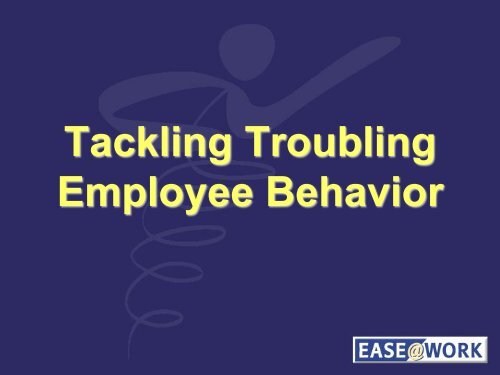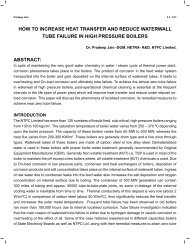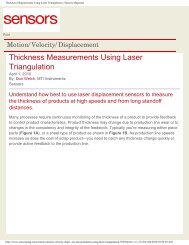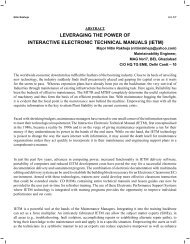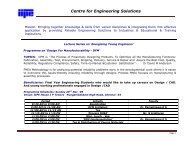Tackling Troubling Employee Behavior
Tackling Troubling Employee Behavior
Tackling Troubling Employee Behavior
You also want an ePaper? Increase the reach of your titles
YUMPU automatically turns print PDFs into web optimized ePapers that Google loves.
<strong>Tackling</strong> <strong>Troubling</strong><br />
<strong>Employee</strong> <strong>Behavior</strong>
EMOTION<br />
e·mo·tion<br />
A mental state that arises<br />
spontaneously rather than through<br />
conscious effort and is often<br />
accompanied by physiological<br />
changes; a feeling: the emotions of<br />
joy, sorrow, reverence, hate, and<br />
love.
How might you rate your<br />
emotional stability?<br />
1. My emotions are stable<br />
2. My emotions tend to be stable<br />
3. Don’t know<br />
4. I occasionally feel unstable and have mood<br />
swings<br />
5. I have frequent and significant emotion/mood<br />
swings<br />
• Now think about those in your workplace who<br />
may answer this as a 4 or 5<br />
*http://www.diagnose-me.com/questionnaire/Q2835.html
How does heightened emotion on the<br />
job affect the workplace?<br />
Damages morale<br />
Lessens cooperation<br />
Increases worker conflict<br />
Increases absenteeism<br />
Decreases productivity<br />
Deflects focus from the job<br />
Increases employee turnover<br />
Impairs judgment and reaction times, therefore raising<br />
the risk of errors and accidents
Emotion Principles<br />
• Our emotional responses are learned, usually<br />
patterned.<br />
• Involves mental conversations that deal with<br />
contradictions to our beliefs and expectations.<br />
• Negative emotions, such as anger, are internally<br />
created and thus can be internally managed.<br />
• Our feelings are most often expressed to those<br />
that are meaningful to us.
Plutchik’s Wheel of Emotions
The Emotion Effect<br />
If left unresolved or unaddressed, a primary<br />
emotion can lead to a secondary emotion,<br />
and ultimately to a tertiary emotion.<br />
Example: Anger > Rage > Hostility<br />
Sadness > Neglect > Alienation<br />
Fear > Horror > Panic
Troubled<br />
trou·bled<br />
Disturbed, worried, distressed,<br />
agitated.
Why might your employee be<br />
troubled…<br />
• Are they displeased with the<br />
outcome of a situation?<br />
• Were expectations unmet?<br />
• Was there a misunderstanding?<br />
• Do they feel things are out of<br />
their control?<br />
• Do they feel mistreated?<br />
• Are they creating their own<br />
internal stress?
Can they control/stabilize their mood and<br />
actions?
From Expectations to Responses<br />
EMOTION<br />
Primary Feeling<br />
Mental Conversion<br />
<strong>Behavior</strong>al Response<br />
Situation<br />
Expectation
Warning Signs:<br />
•Obsessive involvement or emotional<br />
attachment to the job<br />
•Prone to making direct or indirect threats<br />
•Aggressive, anti-social behavior<br />
•Overreaction to work policies or<br />
performance appraisals<br />
•Inconsistent or apathetic work performance<br />
•Stressed relationships with co-workers<br />
•Frequently irritable, moody or sarcastic<br />
behavior
Keep in mind…<br />
Persistent or excessively irritable,<br />
angry behavior may be a symptom of a<br />
larger psychological problem –<br />
such as:<br />
Addiction<br />
Post-traumatic stress disorder<br />
Depression
Common causes of<br />
supervisor/employee conflict:<br />
• Poor communication<br />
• Disrespect/undermining authority<br />
• Betrayal of trust<br />
• Excessive negative feedback from manager<br />
• Unreasonable demands made by managers<br />
• General harassment – sexual, bullying<br />
• Failure of a manager to take disciplinary action<br />
when needed<br />
• Micromanaged environment with little<br />
opportunity for decision making
DEFENSE OR TRAP DESCRIPTION OR EXAMPLE COUNTER MOVE<br />
Excuses & Sympathy<br />
Problems<br />
<strong>Employee</strong>s will have a good reason for everything that happens.<br />
“You’d have the same troubles I do if you had a family like mine.”<br />
“You may have problems at home. I am<br />
concerned about your performance and my<br />
data here says you are not doing your job. ”<br />
Apology & Promises “I’m really sorry. You know that I’ll never do it that way again.” “I appreciate your apology. But what you did is<br />
serious. I need to file a deficiency report.”<br />
Switching<br />
“I know about that, but look what a good job I’ve done on that Harris<br />
job!”<br />
“You did do well on Harris. I want good work<br />
on all jobs. You have had more problems than<br />
success lately. Look at the record.”<br />
Anger<br />
“Damn it! One mistake and the roof falls in – after 15 years of killing<br />
myself for this place.”<br />
“I expect you to listen to me. Just getting<br />
angry won’t help anyone, especially you. I’m<br />
concerned about your performance. And I’m<br />
not talking about one mistake. Look at the<br />
record.”<br />
Tears “I don’t know what to do. I’ll never get out of this mess.” (Cryin “I appreciate your feelings. I want you to know<br />
that I want to help, which is why I set up this<br />
meeting. You have been a valuable part of our<br />
organization. I want to tell you about our<br />
<strong>Employee</strong> Assistance Program.”<br />
Self Pity<br />
Innocence & Blaming<br />
Friendliness & Deduction<br />
“I knew this would happen. I’ve never been able to do anything<br />
right.”<br />
“It’s not my fault. Joe let me down. I don’t get any help at all around<br />
here.”<br />
“Now, you know we’ve been through this before and we worked it out<br />
together. Let’s get together after work and figure this out where we<br />
can be more comfortable. ”<br />
“I wouldn’t be taking the time to talk with you if<br />
I didn’t have faith in you. So let’s move on to<br />
talk about what can be done to help. You<br />
know our <strong>Employee</strong> Assistance Program could<br />
help.”<br />
“I’ve checked into this in detail (points to<br />
record). We need to start with what we can<br />
do.”<br />
“I know we’ve been through this before, and<br />
this time things will be different. I am filing a<br />
report because I’ve done all I can do to work<br />
this out on the job. I think something is wrong<br />
and I want you to see the EAP.”<br />
Hopelessness “I may as well quit right now.” “You may have done excellent work. I<br />
want more of that from your department<br />
which is why I set up this meeting.”
When is an <strong>Employee</strong> Considered<br />
High Risk?<br />
• It is advisable to seek consultation from <strong>Employee</strong><br />
Relations immediately when you have knowledge of<br />
employees presenting with the following traits or<br />
behaviors, especially more than one:<br />
• Known history of violence<br />
• Preoccupation with violence or weapons (or owns<br />
weapons)<br />
• Threats with intent to harm self, others, and property<br />
• Defiant/ demanding/intimidating behavior<br />
• Frequent disruptive behavior in the workplace<br />
• Mood swings
How to Counsel Troubled<br />
<strong>Employee</strong><br />
Step 1:<br />
Take note of dramatic changes in the employee's<br />
performance and on-the-job behavior.<br />
• Adequate documentation will assist you in evaluating job<br />
performance and confronting an employee when<br />
necessary.<br />
– Documentation should be:<br />
• Specific<br />
• Objective<br />
• Factual<br />
• Thorough<br />
• Timely
What to look for and document in<br />
job performance:<br />
1. Absenteeism (Most Obvious)<br />
– Frequent unscheduled short-term absences (with or<br />
without medical explanation)<br />
– Frequent use of unscheduled vacation time.<br />
2. “On the Job” Absenteeism<br />
– At work but productivity and efficiency lacking<br />
– Continued absence from job location more than job<br />
requires<br />
– Frequent trips to water fountain or restroom<br />
– Long breaks.
What to look for and document in<br />
job performance:<br />
3. Accidents<br />
• Physical complaints on the job<br />
• Accidents on and off the job<br />
4. Observed Changes in Work Pattern<br />
• General absentmindedness, forgetfulness<br />
• Alternative periods of high and low productivity<br />
• Coming to work intoxicated<br />
• Missed deadlines<br />
• Inability to perform tasks they were able to do in the past
What to look for and document in<br />
job performance:<br />
4. Observed Changes in Work Pattern (Cont.)<br />
• Mistakes due to poor judgment<br />
• Outside complaints about the employee’s work<br />
• Improbable excuses for these poor patterns<br />
• Carelessness<br />
5. <strong>Employee</strong> Relationships on The Job<br />
• Overreaction to real or imagined criticism<br />
• Borrowing money from co-workers<br />
• Repeated and compulsive criticism of Department or<br />
University
What to look for and document in<br />
job performance:<br />
6. <strong>Employee</strong> Relationships on The Job<br />
(cont.)<br />
• Unrealistic expectations for promotion<br />
• Abrasiveness with others (managers and coworkers)<br />
7. Work Relationships in the University<br />
Community<br />
• Inappropriate behaviors<br />
• Complaints from other departments or customers
What to look for and document in<br />
job performance:<br />
8. Changes In <strong>Employee</strong>’s <strong>Behavior</strong><br />
Appearance<br />
– Sloppy<br />
– Inappropriate clothing<br />
– Mood<br />
– Withdrawn<br />
– Sad<br />
– Mood swings (high and low)<br />
– Suspiciousness<br />
– Extreme sensitivity<br />
– Frequent irritability
How to Counsel Troubled<br />
<strong>Employee</strong> Continued…<br />
• Step 2:<br />
Meet with the employee and determine whether<br />
the problem is personal or job-related.<br />
• Step 3:<br />
Avoid becoming involved in an employee's<br />
personal problem. If the employee needs<br />
professional help (including anger management),<br />
put him or her in touch with <strong>Employee</strong> Relations<br />
or EASE.
How to Counsel Troubled<br />
<strong>Employee</strong>s Continued…<br />
• Step 4:<br />
Focus on performance issues if the trouble is jobrelated.<br />
In a calm, non-accusatory manner, point out<br />
the changes in the employee's performance.<br />
• Step 5:<br />
Ask what you can do to help.<br />
• Step 6:<br />
Work with the employee to develop concrete goals<br />
and a timeline for resolving the performance issues.<br />
– Do establish the levels of work performance you<br />
expect. Set the limits that you will tolerate.<br />
– Determine what is acceptable and unacceptable to<br />
you.<br />
– Be consistent. Treat all employees equally.
How to Counsel Troubled<br />
<strong>Employee</strong>s Continued…<br />
• Step 7<br />
• If the person shows behavior that poses a direct threat to<br />
themselves or others (including physically being unable<br />
to perform at work safely), call <strong>Employee</strong> Relations<br />
and/or Security immediately. A condition of employment<br />
or mandatory referral can be made that requires the<br />
person to be evaluated by a mental health professional<br />
via EASE or outside EASE and recommendations made<br />
as to whether the individual can safely and effectively<br />
perform in the job. They would be on a suspension<br />
during this period to give them time to provide<br />
documentation from their physician. Once we receive<br />
documentation, they can be placed on a leave.<br />
• Important: If you feel threatened, you should suspend<br />
immediately and deactivate the employee’s accesses.
How to Counsel Troubled<br />
<strong>Employee</strong>s Continued…<br />
If you suspect an employee is under the influence<br />
Step 1:<br />
Take note of dramatic changes in the employee's performance<br />
and on-the-job behavior.<br />
• Adequate documentation will assist you in evaluating job<br />
performance and confronting an employee when necessary.<br />
– Documentation should be:<br />
• Specific<br />
• Objective<br />
• Factual<br />
• Thorough<br />
• Timely
How to Counsel Troubled<br />
<strong>Employee</strong>s Continued…<br />
Observations may include:<br />
• Odors (smell of alcohol, body odor or urine)<br />
• Movement (unsteady, fidgety, dizzy)<br />
• Eyes (dilated, constricted, watery, involuntary eye<br />
movements)<br />
• Face (flushed, sweating, confused)<br />
• Speech (slurred, slow, distracted mid-thought)<br />
• Emotions (argumentative, agitated, irritable)<br />
• Change in performance (errors, failure to follow through,<br />
inability to multi-task)
How to Counsel Troubled<br />
<strong>Employee</strong>s Continued…<br />
Step 2:<br />
‣ Contact <strong>Employee</strong> Relations (ER) immediately for advice and<br />
guidance.<br />
‣ In consultation with ER, prepare the Positive Corrective Action form<br />
placing the employee on an investigatory suspension.<br />
‣ Schedule the suspension meeting with the employee and ER<br />
representative or another supervisor, if an ER representative is not<br />
available, as soon as possible.<br />
‣ During meeting, recap previous meetings and refer to<br />
documentation of observed behaviors or performance issues.
How to Counsel Troubled<br />
<strong>Employee</strong>s Continued…<br />
‣ A mandatory management referral will be made to the<br />
<strong>Employee</strong> Assistance Program, EASE.<br />
‣ EASE will determine if a treatment program is<br />
necessary.<br />
‣ The employee will be placed on an investigatory<br />
suspension until documentation from a Health Care<br />
Provider is submitted. At that time, the employee will be<br />
on a personal medical leave.
Summary of Supervisory Guidelines<br />
Focus on behavior<br />
• Observe<br />
• Document<br />
Confront and Support the <strong>Employee</strong><br />
• Don’t diagnose<br />
• Use documentation<br />
Follow Through<br />
• Monitor and document<br />
• Be consistent
<strong>Employee</strong> Assistance Program<br />
(EASE)<br />
• Assists troubled employees in handling personal and/or<br />
health related problems that adversely affect job<br />
performance and productivity.<br />
• Supervisors are responsible for considering EASE as an<br />
option for an employee whose work performance or<br />
behavior/conduct is not meeting standards or could<br />
warrant corrective action.<br />
• Supervisors must contact <strong>Employee</strong> Relations or Human<br />
Resources Administrator before taking action when work<br />
performance issues occur and/or corrective action is<br />
warranted.
Case Studies<br />
• Joe <strong>Employee</strong> (JE) seemed really angry when he came into work;<br />
he slammed doors and was extremely gruff with several coworkers.<br />
Although what he was saying couldn’t be clearly<br />
understood, JE was observed talking to himself in an aggravated<br />
manner. What should JE’s manager do?<br />
• For the past two weeks, Sydney <strong>Employee</strong> (SE) has refrained<br />
from joining her team’s internal meetings as well as her<br />
extracurricular work softball team games. She avoids<br />
conversation and has been withdrawn. When approached, she<br />
“doesn’t feel like talking.” Her work assignments have shown lack<br />
of effort. What should SE’s manager do?<br />
• Kathy <strong>Employee</strong> (KE) has been voicing concerns to her manager<br />
that she fears she’s being followed at work and at home and that<br />
her phone line is tapped. What should KE’s manager do?
The EAP Can Help!<br />
Anything from anger management to EFT<br />
techniques to conflict coaching, to<br />
management skill-building…the EAP can<br />
improve productivity and profits, help build<br />
relationships and repair them, and<br />
enhance employee morale.
USE YOUR RESOURCES<br />
You can benefit from the EAP’s services:<br />
• Consultation<br />
• Assessment and Referral<br />
• Case Monitoring


